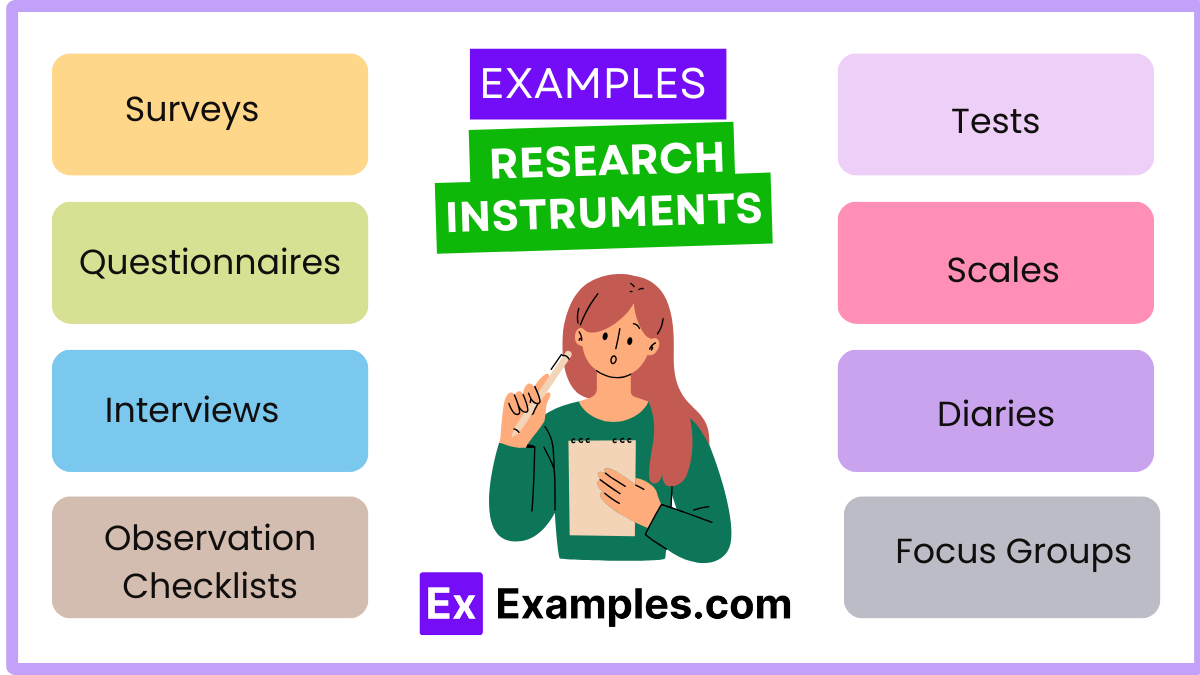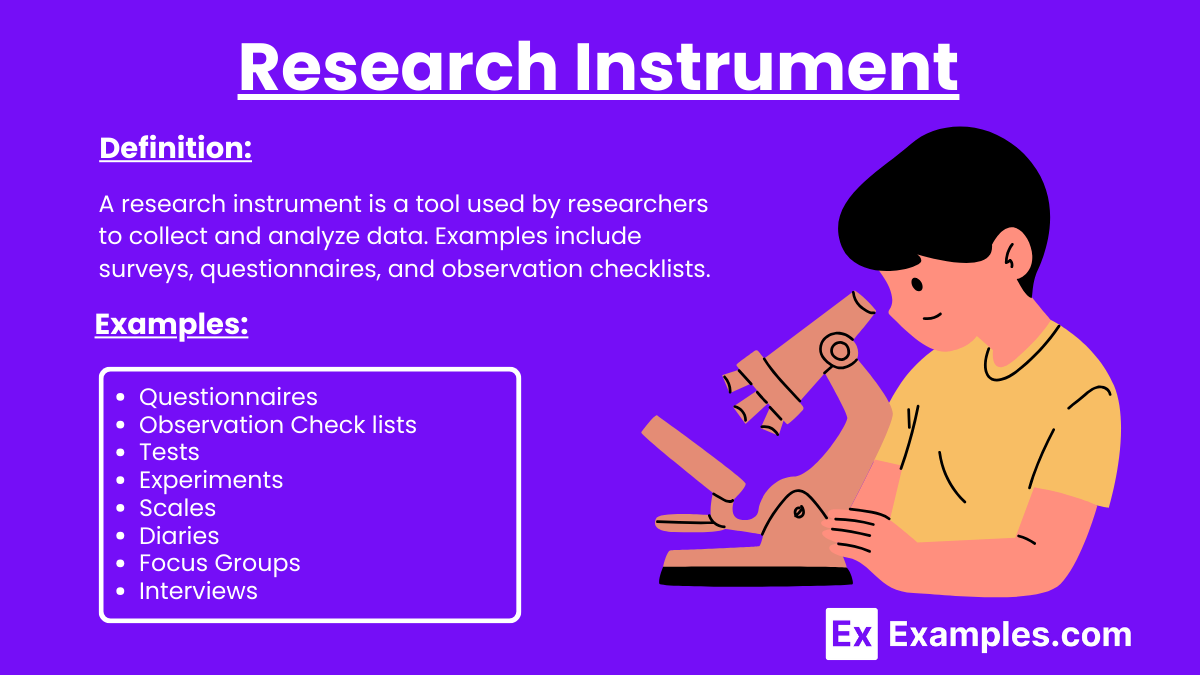25+ Research Instrument Examples
A research instrument is a tool or device used by researchers to collect, measure, and analyze data relevant to their study. Common examples include surveys, questionnaires, tests, and observational checklists. These instruments are essential for obtaining accurate, reliable, and valid data, enabling researchers to draw meaningful conclusions and insights. The selection of an appropriate research instrument is crucial, as it directly impacts the quality and integrity of the research findings.
What is a Research Instrument?
A research instrument is a tool used by researchers to collect and analyze data. Examples include surveys, questionnaires, and observation checklists. Choosing the right instrument is essential for ensuring accurate and reliable data.
Examples of Research Instruments

- Surveys: Structured questionnaires designed to gather quantitative data from a large audience.
- Questionnaires: Sets of written questions used to collect information on specific topics.
- Interviews: Structured or semi-structured conversations used to obtain in-depth qualitative data.
- Observation Checklists: Lists of specific behaviors or events that researchers observe and record.
- Tests: Standardized exams used to assess knowledge, skills, or abilities.
- Scales: Tools like Likert scales to measure attitudes, perceptions, or opinions.
- Diaries: Participant logs documenting activities or experiences over time.
- Focus Groups: Group discussions facilitated to explore collective views and experiences.
Examples of a Quantitative Research Instruments
- Structured Surveys: These are detailed questionnaires with predefined questions and response options, designed to collect numerical data from a large sample. They are often used in market research and social sciences to identify trends and patterns.
- Standardized Tests: These are assessments that measure specific knowledge, skills, or abilities using uniform procedures and scoring methods. Examples include IQ tests, academic achievement tests, and professional certification exams.
- Closed-Ended Questionnaires: These questionnaires contain questions with a limited set of response options, such as multiple-choice or yes/no answers. They are useful for gathering specific, quantifiable data efficiently.
- Rating Scales: These tools ask respondents to rate items on a fixed scale, such as 1 to 5 or 1 to 10. They are commonly used to measure attitudes, opinions, or satisfaction levels.
- Structured Observation Checklists: These checklists outline specific behaviors or events that researchers observe and record in a systematic manner. They are often used in studies where direct observation is needed to gather quantitative data.
- Statistical Data Collection Tools: These include various instruments and software used to collect and analyze numerical data, such as spreadsheets, databases, and statistical analysis programs like SPSS or SAS.
- Likert Scales: A type of rating scale commonly used in surveys to measure attitudes or opinions. Respondents indicate their level of agreement or disagreement with a series of statements on a scale, such as “strongly agree” to “strongly disagree.”
Examples of a Qualitative Research Instruments
- Open-Ended Interviews: These interviews involve asking participants broad, open-ended questions to explore their thoughts, feelings, and experiences in depth. This method allows for rich, detailed data collection.
- Focus Groups: A small, diverse group of people engage in guided discussions to provide insights into their perceptions, opinions, and attitudes about a specific topic. Focus groups are useful for exploring complex behaviors and motivations.
- Unstructured Observation: Researchers observe participants in their natural environment without predefined criteria, allowing them to capture spontaneous behaviors and interactions in real-time.
- Case Studies: In-depth investigations of a single individual, group, event, or community. Case studies provide comprehensive insights into the subject’s context, experiences, and development over time.
- Ethnographic Studies: Researchers immerse themselves in the daily lives of participants to understand their cultures, practices, and perspectives. This method often involves long-term observation and interaction.
- Participant Diaries: Participants keep detailed, personal records of their daily activities, thoughts, and experiences over a specific period. These diaries provide firsthand insights into participants’ lives.
- Field Notes: Researchers take detailed notes while observing participants in their natural settings. Field notes capture contextual information, behaviors, and interactions that are often missed in structured observations.
- Narrative Analysis: This method involves analyzing stories and personal accounts to understand how people make sense of their experiences and the world around them.
- Content Analysis: Researchers systematically analyze textual, visual, or a content to identify patterns, themes, and meanings. This method is often used for analyzing media, documents, and online content.
- Document Analysis: Researchers review and interpret existing documents, such as reports, letters, or official records, to gain insights into the context and background of the research subject.
Characteristics of a Good Research Instrument
- Validity: A good research instrument accurately measures what it is intended to measure. This ensures that the results are a true reflection of the concept being studied.
- Reliability: The instrument produces consistent results when used repeatedly under similar conditions. This consistency is crucial for the credibility of the research findings.
- Objectivity: The instrument should be free from researcher bias, ensuring that results are based solely on the data collected rather than subjective interpretations.
- Sensitivity: The instrument is capable of detecting subtle differences or changes in the variable being measured, allowing for more nuanced and precise data collection.
- Practicality: It is easy to administer, score, and interpret. This includes being time-efficient, cost-effective, and user-friendly for both researchers and participants.
- Ethical Considerations: The instrument respects the rights and confidentiality of participants, ensuring informed consent and protecting their privacy throughout the research process.
- Comprehensiveness: It covers all relevant aspects of the concept being studied, providing a complete and thorough understanding of the research topic.
- Adaptability: The instrument can be modified or adapted for different contexts, populations, or research settings without losing its effectiveness.
- Clarity: The questions or items in the instrument are clearly worded and unambiguous, ensuring that participants understand what is being asked without confusion.
- Cultural Sensitivity: The instrument is appropriate for the cultural context of the participants, avoiding language or content that may be misinterpreted or offensive.
Research Instrument Questionnaire
A questionnaire is a versatile and widely used research instrument composed of a series of questions aimed at gathering information from respondents. It is designed to collect both quantitative and qualitative data through a mix of open-ended and closed-ended questions. Open-ended questions allow respondents to express their thoughts in their own words, providing rich, detailed insights, while closed-ended questions offer predefined response options, facilitating easier statistical analysis. Questionnaires can be administered in various formats, including paper-based, online, or via telephone, making them accessible to a wide audience and suitable for large-scale studies.
The design of a questionnaire is crucial to its effectiveness. Clear, concise, and unbiased questions are essential to ensure reliable and valid results. A well-crafted questionnaire minimizes respondent confusion and reduces the risk of biased answers, which can skew data. Moreover, the order and wording of questions can significantly impact the quality of the responses. Properly designed questionnaires are invaluable tools for a range of research purposes, from market research and customer satisfaction surveys to academic studies and social science research. They enable researchers to gather a broad spectrum of data efficiently and effectively, making them a cornerstone of data collection in many fields.
Research instrument Sample Paragraph
A research instrument is a vital tool used by researchers to collect, measure, and analyze data from participants. These instruments vary widely and include questionnaires, surveys, interviews, observation checklists, and standardized tests, each serving distinct research needs. For example, questionnaires and surveys are commonly employed to gather quantitative data from large groups, providing statistical insights into trends and patterns. In contrast, interviews and focus groups are used to delve deeper into participants’ experiences and perspectives, yielding rich qualitative data. The careful selection and design of a research instrument are crucial, as they directly impact the accuracy, reliability, and validity of the collected data,
How to Make Research Instrument
Creating an effective research instrument involves several key steps to ensure it accurately collects and measures the necessary data for your study:
1. Define the Research Objectives
- Identify the Purpose: Clearly outline what you aim to achieve with your research.
- Specify the Variables: Determine the specific variables you need to measure.
2. Review Existing Instruments
- Literature Review: Look at existing studies and instruments used in similar research.
- Evaluate Suitability: Assess if existing instruments can be adapted for your study.
3. Select the Type of Instrument
- Choose the Format: Decide whether a survey, questionnaire, interview guide, test, or observation checklist best fits your needs.
- Determine the Method: Consider whether your data collection will be qualitative, quantitative, or mixed-methods.
4. Develop the Content
- Draft Questions or Items: Write questions that align with your research objectives and variables.
- Ensure Clarity and Relevance: Make sure each question is clear, concise, and directly related to the research objectives.
- Use Simple Language: Avoid jargon to ensure respondents understand the questions.
5. Validate the Instrument
- Expert Review: Have experts in your field review the instrument for content validity.
- Pilot Testing: Conduct a pilot test with a small, representative sample to identify any issues.
6. Refine the Instrument
- Revise Based on Feedback: Modify the instrument based on feedback from experts and pilot testing.
- Check for Reliability: Ensure the instrument consistently measures what it is supposed to.
7. Finalize the Instrument
- Create Instructions: Provide clear instructions for respondents on how to complete the instrument.
- Format Appropriately: Ensure the layout is user-friendly and the instrument is easy to navigate.
8. Implement and Collect Data
- Administer the Instrument: Distribute your instrument to the target population.
- Monitor Data Collection: Ensure the data collection process is conducted consistently.
FAQ’s
How do you choose a research instrument?
Select based on your research goals, type of data needed, and the target population.
What is the difference between qualitative and quantitative research instruments?
Qualitative instruments collect non-numerical data, while quantitative instruments collect numerical data.
Can you use multiple research instruments in one study?
Yes, using multiple instruments can provide a more comprehensive understanding of the research problem.
How do you ensure the reliability of a research instrument?
Test the instrument multiple times under the same conditions to check for consistent results.
What is the validity of a research instrument?
Validity refers to how well an instrument measures what it is intended to measure.
How can you test the validity of a research instrument?
Use methods like content validity, criterion-related validity, and construct validity to test an instrument.
What is a pilot study?
A pilot study is a small-scale trial run of a research instrument to identify any issues before the main study.
Why is a pilot study important?
It helps refine the research instrument and improve its reliability and validity.
What is an unstructured interview?
An unstructured interview allows more flexibility, with open-ended questions that can adapt based on responses.
What is the role of observation in research?
Observation allows researchers to collect data on behaviors and events in their natural settings.



